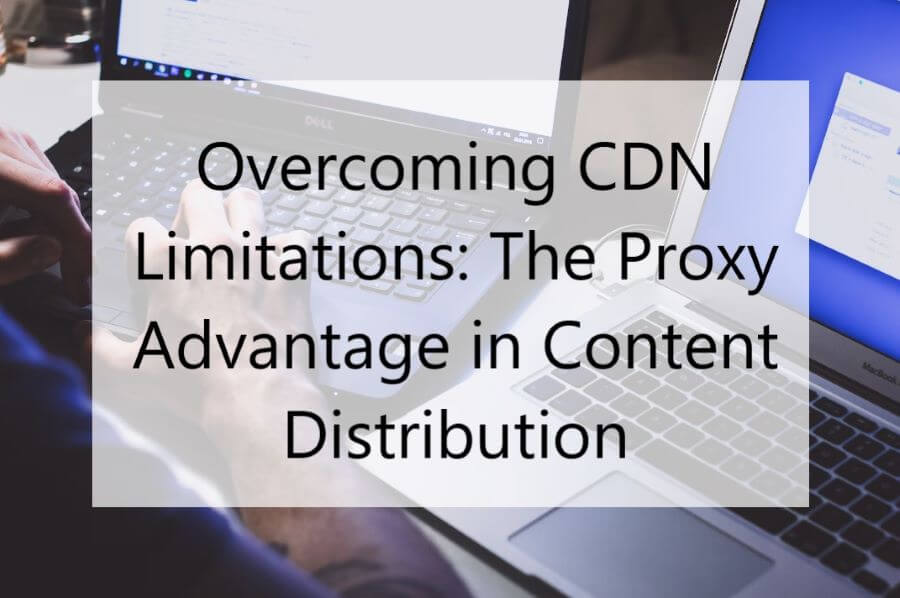Overcoming CDN Limitations: The Proxy Advantage in Content Distribution

Wondering how your favorite online content reaches you so swiftly, no matter where you are? That’s the magic of Content Delivery Networks (CDNs). But sometimes, even magic has its limits. Today, I’ll show you how proxies can supercharge CDNs, pushing past those pesky limitations to deliver content faster and more efficiently.
CDNs and Their Challenges
Picture a CDN as the internet’s speedy courier service. Its job is to store copies of your favorite websites and videos in various locations worldwide. This way, when you click on a video or website, the content reaches you super-fast, as it’s delivered from a location near you. Pretty neat, right?
But, just like any courier service, CDNs face their own set of roadblocks. Let’s break those down!
- Geo-Restrictions: Ever clicked on a video only to see “content not available in your region”? That’s geo-restriction in action. Sometimes, due to licensing laws or other regulations, CDNs block access to certain content in specific parts of the world.
- Traffic Spikes: Imagine everyone in your neighborhood ordering packages at the same time. The delivery system might get overwhelmed, right? Similarly, when too many people try to access the same content simultaneously (like during a live sports event), even the best CDNs can get bogged down. This can lead to slower loading times or, in the worst cases, the dreaded buffering icon.
- Uniform Content Delivery: The internet is a vast buffet of videos, images, web pages, and more. Ensuring that all these are delivered efficiently and uniformly is a big challenge for CDNs.
In short, while CDNs do a fantastic job of speeding up delivery, they’re not perfect. They have to navigate through a maze of regional rules, handle sudden surges in demand, and juggle a variety of content types, all of which can impact how quickly and effectively you get your digital “packages.”
Proxies to the Rescue
Imagine you’re trying to send a special package to a friend in a far-off town, but there are roadblocks and detours all over the place. This is where proxy services step in. They act like savvy local guides who know all the best shortcuts. And here are the three issues they are particularly good at handling:
#1 Dodge Geo-Blocks
Proxies are your remedy for geo-blocks. They let your content sneak through international digital borders by making it appear as if it’s coming from a place where those restrictions don’t exist.
#2 Speed Up Delivery
Proxies can make your content zip through the internet super-fast. Just choose a server that’s close to your audience and you’ll essentially shorten the delivery route.
#3 Handle the Crowd
When lots of people want to see the same things at the same time, proxies help manage the rush. They spread out the requests, so your main server doesn’t get swamped.
Choosing the Right Proxy for Content Distribution
How do you pick the perfect proxy for your goals? Well, for one thing, you need to understand how these solutions differ.
Residential proxies
These are your friendly neighborhood proxies. They blend in just like any regular internet user because they use real residential IP addresses. Here’s why they’re cool:
- Geo-spoofing: If your content needs to reach viewers in different corners of the world, these proxies are your passport. They’re like having a local address in multiple cities.
- Acting Like a Regular Joe: When you need to distribute content without setting off any alarms, residential IPs are your go-to.
Learn more about geo-spoofing and how to master it.
Datacenter proxies
Think of these as your high-speed trains. They’re housed in data centers, and they’re all about speed and power. Here’s where they shine:
- Zooming Through Traffic: Got a lot of data to push out fast? These servers are your express lane.
- Handling the Crowds: Expecting a surge of users? Datacenter proxies can handle the rush hour without breaking a sweat.
Rotating Proxies
Imagine having a shape-shifter on your team. That’s a rotating proxy. It changes the IP address often, so it’s hard for anyone to pin it down. Such solutions are great for:
- Playing It Smart: By constantly changing IPs, they spread out the load and keep your data moving smoothly.
- Staying Under the Radar: If you’re worried about getting blocked or throttled, they keep things fresh and elusive.
So, which one to pick? Here are a few questions that can be of help:
- What are you delivering? Videos, images, or text?
- Where’s your audience? If they’re spread out globally, residential proxies might be your best bet.
- Expecting a traffic jam? If you’re gearing up for high traffic, consider datacenter or rotating proxies.
Setting Up Proxies for Enhanced CDN Performance

Boosting your CDN with proxies might sound like a tech wizard’s job, but trust me, it’s something you can easily tackle. Let’s walk through this together, step by step.
First Things First: What Do You Need?
Before anything else, take a moment to think about what you’re trying to achieve. Are you looking to get around those annoying geo-blocks? Are you more concerned about handling a flood of traffic during peak hours? Maybe you’re aiming to speed up content delivery across the globe.
Your goal here will steer you toward the right type of solution. It’s like picking the right tool for a job — you wouldn’t use a hammer to screw in a bolt, right?
Choose Your Proxy
You know your needs and now, onto the fun part — picking your proxy. We’ve already reviewed what each solution is fit for so let’s just wrap up.
If you’re dealing with geo-restrictions, residential IPs are your secret key to unlocking content worldwide. For those of you bracing for high traffic, datacenter proxies are superb as they’re fast and can handle a lot of pressure. And if you need a bit of everything, rotating proxies are versatile and ready for any challenge.
Integrate Proxies with Your CDN
Here’s where you roll up your sleeves. To integrate your chosen solution with your CDN, you must tweak some settings. You’ll need to tell your CDN to route traffic through your proxy. This is where you input the IP address and port number of your proxy server into your CDN’s settings.
After you’ve set it all up, test it out. You want to make sure that your content is not just reaching its destination but also doing it faster and more efficiently.
Keep an Eye on Performance
Once everything’s up and running, don’t just walk away. Keep an eye on how things are going. Is your content reaching further? Are loading times faster? If something’s not quite right, don’t be afraid to go back and adjust your settings.
Sometimes a small tweak can make a big difference. And remember, the internet’s always changing so stay updated with the latest in proxy and CDN tech.
Security Matters, Too
In all this talk about speed and access, let’s not forget about security. Make sure your provider values your safety as much as you do. Encrypted connections are a must to keep your data secure as it travels.
Proxy Performance Metrics You Should Monitor
When you’re using proxies to boost your CDN, it’s not enough to have them in place. You must also ensure they’re doing their job well. To get a grip on this, you need to understand and monitor specific performance metrics. These are like the vital signs for your CDN’s health:
- Response Time: This is how long it takes for your proxy to respond to a request. Faster response times mean quicker delivery. If your proxy is sluggish, it could be slowing down your entire CDN.
- Uptime: Uptime is the amount of time your proxy is up and running smoothly. If it is frequently down, it’s like having a broken link in the chain. This can lead to potential delivery interruptions.
- Bandwidth Usage: This metric shows the amount of data your proxy is handling over a period. This helps you understand if it can handle the load, especially during peak traffic times.
- Error Rates: This refers to the number of failed requests or errors generated by your proxy. A high error rate can indicate problems with the server. It’s a sign that something needs fixing, whether it’s a configuration issue or a need for a more robust solution.
- Cache Hit Ratio: For proxies that cache content, this ratio indicates how often the proxy server content from the cache versus retrieving it from the original server. A high cache hit ratio means your solution is efficiently serving cached content, reducing load times and server requests.
Learn more about important proxy performance metrics and how to check them.
Wrapping Up
And there we have it — a complete walkthrough on using proxies to give your CDN that extra edge. It’s not just about overcoming limitations (or, more specifically, not only about that). From a broader perspective, it’s about unlocking a new level of content distribution efficiency. Here are the key takeaways worth remembering:
- Proxies help bypass geo-restrictions, manage traffic loads, and speed up content delivery.
- Match your choice of solution to your specific needs — residential for geo-dodging, datacenter for high-speed delivery, and rotating for versatility.
- Properly integrate your proxies with your CDN and always test to ensure optimal performance.
- Keep an eye on response time, uptime, bandwidth usage, error rates, and cache hit ratio to gauge proxy efficiency.
- Ensure your provider offers encrypted connections to protect your content.
